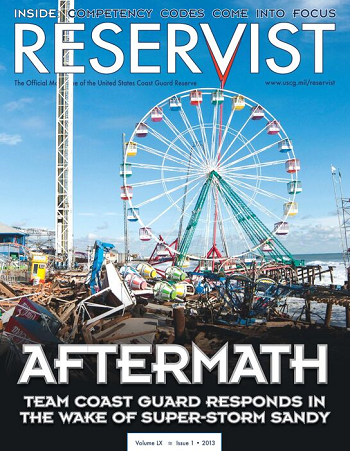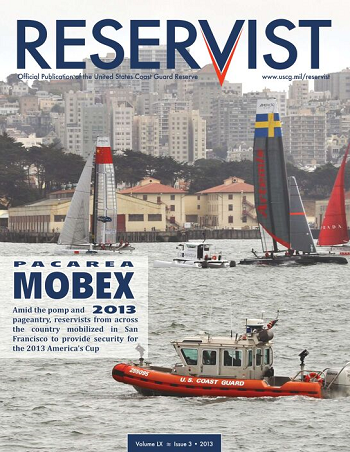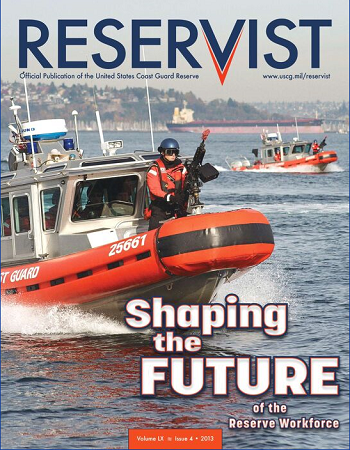
From the Editor - As we settle into our second full year as a quarterly – four times a year – publication you will find this issue of the Reservist loaded with content; some timely and some timeless. Our editorial formulation is straight forward: provide interesting and informative stories about issues and events impacting the Coast Guard Reserve program, the reservists it supports, and, more broadly, the Coast Guard writ large.
In this issue, for example, the cover story is on the impact, response and aftermath left in the wake of Super-Storm Sandy. We also have an extended feature on Reserve-focused competencies, which support the strategic guidance found in the Commandant’s Reserve Policy Statement. Rear Adm. Dean Lee writes The View in which he sets out the Deputy Commandant for Operations (DCO) vision for how and where reservists fit within DCO’s world of work.
We are also please to have the Coast Guard’s Ancient Keeper, Master Chief James Clemens offer sage wisdom in Deckplate Soundings about the value and importance of effectively building proficiency through focused training.
In addition, the Office of Boat Forces addresses a number of Reserve workforce initiatives it is currently pursuing. There are numerous competency related stories including how small boat stations are training and utilizing their reservists to accomplish their missions. We refer to these stories as the “human-face” of policy: where the decisions made by senior leaders and program managers intersect with the reality of day-to-day operations.
You will find valuable information of available training opportunities at the Maritime Law Enforcement Academy as well as how to ensure you receive credit for competencies and qualifications earned.
For sure, there is much technical jargon to be found as you peruse the magazine’s content, but you will also discover a number of stories about your Coast Guard in action. You will read about a joint FBI-CG case in California, new Title 14 recall entitlements, how training played a key role in a reservist’s survival during a line-of-duty shooting, as well as a smattering of what’s happening Around the Reserve.
As always, thanks for reading.
Click cover image to download a printable pdf

From the Editor - Greetings. This will be the last From the Editor column written from Cube 08-1009 located here in the Jemal Building in Southwest, DC as the Coast Guard begins its move to our new digs at the St. Elizabeth site across the Anacostia River in August. While change is always a bit unsettling, we are excited about the new facility: a facility designed and built specifically for the Coast Guard.
We are also excited about the content in this issue of the Reservist in which we continue to bring you the latest news about organization initiatives as well as what we hope you find to be interesting stories about the happenings Around the Reserve.
We are particularly pleased to have yet another The View from the Bridge guest column. It is coauthored by Vice Admiral Robert C. Parker and Vice Admiral Paul F. Zukunft, Commanders Atlantic Area and Pacific Area, respectively, in which they share their perspectives as to, “the contributions of the Reserve Component across the full spectrum of Coast Guard missions performed daily around the world.”
This issue’s Feature Story expands on the Area commander’s strategic overview with a joint-Area Reserve Force Readiness System (RFRS) staff update. District and sector RFRS staff personnel provide articles about best practices and the value RFRS brings to Reserve readiness and competency at the deckplate. In addition, there is an update from the Deputy of Operational Logistics RFRS staff (DOL-31) on initiatives underway to ensure reservists are ready as reliable force multipliers in support of the Service’s mission support functions.
We are also pleased with the number of excellent stories we can offer thanks to the contributions of many field Public Affairs (PA) specialists. The support we continue to receive from PAs around the Coast Guard, both active duty and Reserve, is outstanding. If you see one in your travels, be sure to thank them for telling your stories so well.
As always, thanks for reading.
Click cover image to download a printable pdf

From the Editor - Hello from our digs at the Coast Guard’s new headquarters building located on the historic St. Elizabeth’s Hospital site in the District of Columbia’s Southeast section. St. Es, as it is known locally was the first large-scale, federally run psychiatric care hospital.
Arriving on Monday, August 5th, we at the Reservist, along with the rest of the Office of Reserve Affairs, were among the first “pioneers” to occupy our new home. Our work spaces are open and bright. Each day seems to bring a new discovery – like the American Bald Eagle who also calls St. Elizabeth’s home.”
Speaking of new discoveries, in this issue you will find a new section devoted to Coast Guard history. Going forward we plan to run at least one story about our service’s history in each issue. The two stories in this issue are set during the Second World War when over 92% of Coast Guardsmen in uniform were reservists.
In this issue you will also gain insights about the status of Reserve Training Appropriation as seen through the eyes of Rear Adm. Steven Day (View from the Bridge) and guest columnist Master Chief Petty Officer Eric Johnson (Deckplate Soundings).
Our Feature Story showcases Pacific Area’s MOBEX 2013 which used the real world America’s Cup 34 Race event to test and improve on Coast Guard Reserve mobilization readiness. We are extremely grateful to the 11th District Public Affairs staff, particularly PAC Sherri Eng, for coordinating and providing outstanding coverage of the reservists from around the country who supported the MOBEX. Be sure to check out our on-line edition to see the video which captured some of these members in action.
Finally, we are always on the lookout for interesting stories particularly for our Around the Reserve section where we like to recognize reservists and highlight the Reserve contribution to the Coast Guard mission. If you have something you think would be of interest to our readers, feel free to contact us and discuss the possibility of having your story published.
As always, thanks for reading.
Click cover image to download a printable pdf

From the Editor - Funny how we associate times in our lives with certain things: places, events, people. People like Sterling W. J. Farrenkopf. To you, I suspect, that name means little if anything. It transports me back to the time of teletyped message traffic, 12 knots boats, and, most importantly, first impressions.
Sterling crossed the bar this past Thanksgiving. He was laid to rest in a small, peaceful cemetery on Cape Cod on December 7th. A bit of poetic symmetry there, I think, for a World War II Navy veteran. In the years following the end of the war and his discharge from the Navy, he enlisted in the Coast Guard Reserve.
I think he was the first reservist I met when I reported to Reserve Unit Station Chatham in June 1976. He certainly was the one who made the biggest impression. As I remember he was a Radioman 1st Class. I have a vivid memory of him sitting behind the drab green console in the Station Chatham watch room with its never-ending view of the Atlantic Ocean. To the uninitiated – me -- it seemed like utter chaos: multiple radios belching out incoherent chatter, the constant sound of the radio directional finder sending out its repetitive Morse code signal for the ships at sea, and the clank, clunk, clank of the teletype machine. And there, amidst all this, sat Sterling, calmly responding to the radios, answering the phone and drafting telexes, all seemingly at the same time. I was simultaneously intimidated and impressed.
Petty Officer Farrenkopf would retire later that year, but for a few months I had the benefit of his tutelage as I began the process of becoming watch stander qualified. That I was eventually able to decipher the noise emanating from the radio console and draft relatively error-free telexes stands as a testament to Sterling’s professionalism and patience in dealing with someone less than half his age.
In all, I spent 15 years at Station Chatham. Over that time I served with countless active and Reserve crewmembers. More than a few made a lasting impression. But few more so than Sterling W. J. Farrenkopf, a man I wish I had gotten to know better. And, for sure, a man I am better for having known.
As always thanks for reading.
Click cover image to download a printable pdf